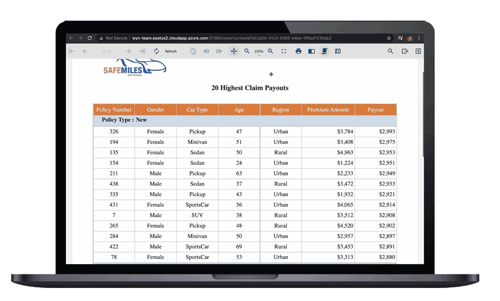Business intelligence reporting is the process of collecting, organizing, and analyzing relevant data for defined audiences. Business intelligence (BI) reporting tools help make data understandable to different audiences. BI reporting transforms information into action. Data isn't isolated anymore; it becomes one of a business's most valuable resources with context.
Actionable BI reporting collects and presents relevant data to users to help them analyze and understand what's happening in the business to take action.
Why You Need Actionable Business Intelligence Reporting
Many business intelligence reports have a significant problem—your audience isn't reading or acting on the data you're sharing. You've put a lot of effort into creating insightful and accurate BI reports, but there's still a gap. You know you're surfacing vital information through your BI reporting tools and embedded BI, so how do you drive that next step?
Here, we'll give an overview of how to create actionable BI reports by applying reporting principles and best practices to help your audience make strategic decisions.
Types of BI Reports that Drive Actionable Decisions
Whether you're embedding BI reports in an application or product or using a BI reporting tool to understand your business, you can focus on actionable decisions across several types of reports:
- Snapshot and moment-in-time performance reports together with targets, thresholds, and alarms to draw attention and drive decisions.
- Reports over time include historical trends or future forecasting so users can see how the current state has changed over time or will change in the future.
- Ad hoc reports that users can build and customize themselves for immediate or temporary needs.
- Managed and admin reporting where a reporting analyst prepares and presents data for a non-technical user.

How to Create Effective BI Reports
Firstly, you'll want to figure out the purpose of a BI report before you start building it. That means talking to your audience/users to understand their needs and intent.
Once you know those requirements, you will need to translate those needs and decision-making criteria into the BI metrics you can measure, create, or derive. You'll also need to source reliable and timely information to inform your reports.
Translate Needs into Measurable Data
Ask users about their initial thoughts on the BI reports that can help them—there are several areas you can cover:
- Which reports do you use currently? Do you need or want any additional reports or information?
- Why do you need this report?
- Who will use this report?
- What type of device will they use to access the report?
- How frequently will they use this report?
Discover, document, and verify the actions a user needs to take and the information they need. Let them tell you how they make those decisions.
Break down the decision into its key parts—each of these parts may have data supporting it. A good report helps support every stage of a decision.
Define data for each part of the decision. Think about the metrics you already have access to and additional metrics that you can collect.
You can then start building report prototypes and sharing those early reports with your stakeholders to ensure the BI meets their needs. This preliminary step ensures the reporting metrics are an accurate story and a proper reflection of business data.
Add Context for Actionable Reporting
As you're building out and refining the reports, always consider the context where the BI reports will be used. Tie the data you're showing directly back to the user needs you identified earlier. You may want to include trends, previous activities, or circumstances driving results.
Don't be tempted to add too much to a report. Instead, focus on keeping your information succinct, providing only the contextual data that's needed to drive decisions.
Launch and Refine Your Report
It's time to finalize the report with the end-user. Make sure it meets their decision-making needs. Once you've launched it into production, follow up with the user a couple of times a year. If it's not meeting user needs, work with them to tweak and refine the report.
These principles support every type of BI tool and approach, from embedded, app-specific reports through general business overviews to department and team-based BI reporting.

Business Intelligence (BI) Reports | Wyn Report Designer
Best Practices for Actionable Business Intelligence Reports
In addition to making sure your BI report aligns BI reports with business strategy and user needs, review the high-level business strategy to understand the business's current state, challenges, opportunities, and goals.
Understand the metrics and KPIs you can currently report on—map the most relevant measurements onto the user's decision-making process.
Identify if there are other measures you can collect, calculate, or derive that will suit the user's decision-making. Then create a process for data collection.
Verify the quality of your data sources—carry out some preliminary data cleansing, testing, and verification to make sure you're reporting on reliable information.
Build connectors and integrate with data sources, pull together disparate data from across data silos.
BI Report Design Principles
Keep your reports as "clean" as possible. Present only the information the user needs to decide. Do not be tempted to add in extraneous information, as this will distract from the central purpose of the report.
Add necessary context to the critical parts of the report—this might be historical trends and forecasting, extenuating circumstances, or other information. Ensure that this context directly supports the purpose of the report.
Experiment with different ways to show the data (as tables, dashboards, graphs, and other reporting outputs). Think about how the format of the report drives a deeper analysis.
Test and Refine Your BI Reports
Finally, launch the report into production. See how the user is benefiting from the report. You'll want to regularly test your reports with the user to get feedback on how helpful it is to ensure the report remains relevant and useful.
- Launch the report into production. See how the user is benefiting from the report.
- Follow up with the user regularly—check in with the user on how the report is meeting their needs. You could do this on a weekly, monthly, or quarterly basis.

Empower Teams with Powerful BI Reporting
Provide your team with a unified, enterprise-level, self-service data analysis and decision support platform. Wyn Enterprise is a web-based BI platform that provides greater insight into your data.
Wyn offers built-in tools for report and dashboard creation, data governance, security integration, embedded BI, automated document distribution, and a business-user interface for self-service business intelligence.
Wyn's easy-to-use designers allow non-technical business users to build interactive dashboards with drill-down and cross-filter functionality quickly.




























